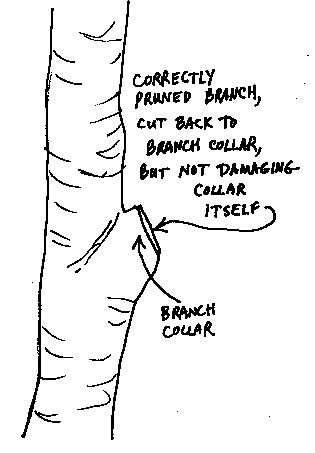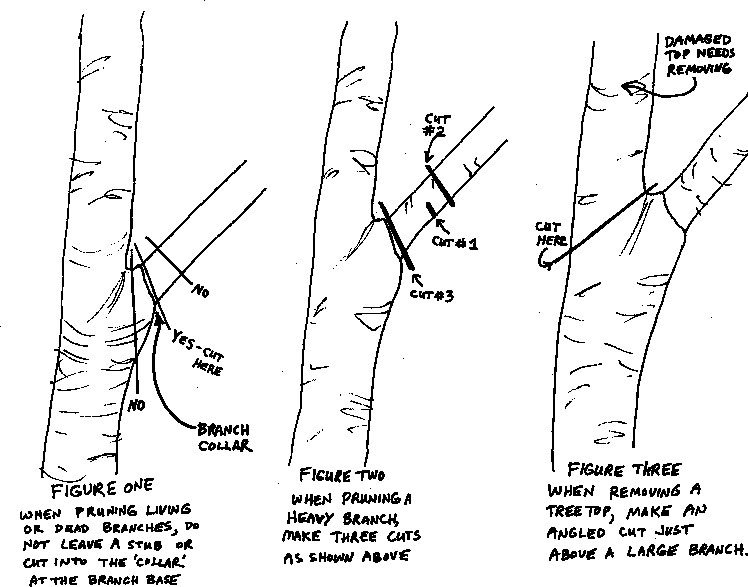 |
| Correctly pruned branch. Bunker illustration. |
By John Bunker
The ice storm in January damaged many thousands of trees throughout much of Maine. Although it wasn’t much more than light rain, and drizzle, it certainly took an incredible toll on our landscape. Fortunately the apple trees fared pretty well in most yards and orchards, most certainly because they’re designed to carry the weight of their crops. The conifers were able to shed a good deal of the ice, but in most locations the deciduous trees got hit hard. Many of us have begun to prune the trees that look salvageable, and to cut down those that don’t. It’s worth keeping a few things in mind as we tackle this huge task.
I’d like to suggest that we take the conservative tack and attempt to save as many trees as possible. The tree in your yard or woodlot may look bad, but in a couple of years it may recover quite well. If you decide to save a tree, consider hiring a professional tree pruner to do the job, especially if it requires climbing. If you decide to do the pruning yourself, a good book on pruning can be very helpful. From my own reading, experience and talking to professionals, I’ve discovered a few things that may help. Most apply to any tree pruning, not just storm reparations.
At the base of a branch, where it meets the trunk, is the branch collar. On most trees it’s a fairly obvious bulge (figure one). On some it’s not quite so obvious, but still recognizable if you take a minute to look carefully. When pruning a living or a dead branch, do not cut into the branch collar; this collar will grow over and heal the cut you make. There is a natural impulse to trim a branch close to the trunk with a flush cut. It looks good and might seem right, but, it’s not. The branch collar provides a protection zone for the tree. Careful pruning that does not injure the collar will usually ensure a healthy tree in the future. Cutting the collar will invite disease, insects and other problems. Even when the collar is quite large, as it is with some trees, you should still leave it all intact. I should add that trees destined for the saw mill will have the greatest percentage of marketable wood when pruned by this method.
While cutting off a branch too close to the trunk is bad for a tree, so is not cutting enough. Do not leave a stub. The stub will die, rot, and also become an invitation to trouble. Cut the stub off neatly, right up to the collar.
Use three cuts to remove heavier branches (figure two). This way, you can remove the heaviest portion of the branch without tearing off bark from the trunk, and then neatly trim off the stub.
Do not apply wound dressing. There is no evidence that wound dressings, compounds, tar, etc., painted over pruning cuts is any help. To the contrary, evidence suggests that these materials invite trouble. Prune the branch and leave it alone to heal. In most cases, it will.
Many of our trees have had their tops snapped off. Pruning the top off a tree is called “heading” or “topping.” Under normal conditions heading a mature tree is never recommended because, unlike a branch, there is no collar or protective zone to protect against disease or insect damage. But leaving a broken top can be worse. While it’s unlikely anyone will even attempt to prune all the top of the trees in their wood lot, heading a few favorite trees near the house might be a good idea. If you do, cut back to a crotch if you can, or cut on an angle back to a large branch, and leave no stub (figure three).
The most commonly recommended pruning tool is a hand saw. Many designs and sizes are available in stores and through catalogs. If you use a chain saw, be extremely careful when cutting near the branch collar. Accidentally cutting the collar with your chain saw will not help your tree to heal. Axes are never recommended for pruning work.
In some cases, nothing you do will save a tree that is going to decline and die. In those cases, you get to decide what to plant next.
John lives in Palermo. He coordinates Fedco Trees.
 |
| Figures 1, 2 and 3. Bunker illustration. |
